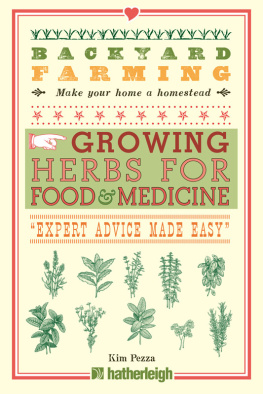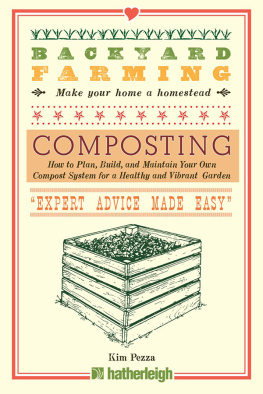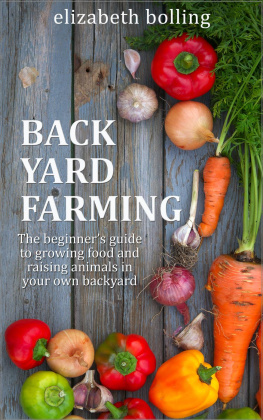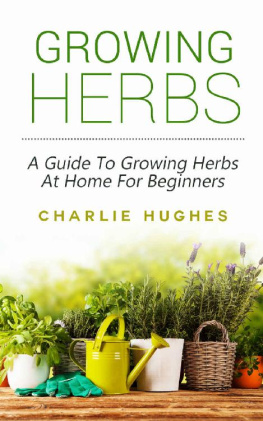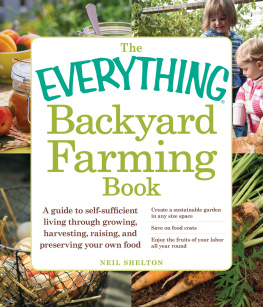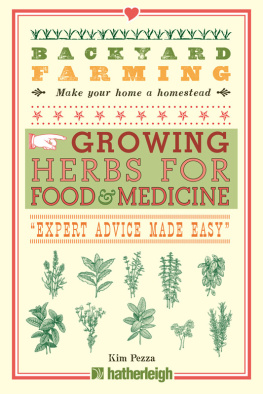
Hatherleigh Press is committed to preserving and protecting the natural resources of the earth. Environmentally responsible and sustainable practices are embraced within the companys mission statement.
Visit us at www.hatherleighpress.com and register online for free offers, discounts, special events, and more.
Backyard Farming: Growing Herbs for Food and Medicine
Text copyright 2019 Hatherleigh Press
Library of Congress Cataloging-in-Publication Data is available upon request.
ISBN: 978-1-57826-800-9
All rights reserved. No part of this book may be reproduced, stored in a retrieval system, or transmitted, in any form or by any means, electronic or otherwise, without written permission from the publisher.
C OVER D ESIGN AND I NTERIOR D ESIGN BY C AROLYN K ASPER
Printed in the United States
10 9 8 7 6 5 4 3 2 1
CONTENTS
Guide

Also in the Backyard Farming Series
Backyard Farming: Canning & Preserving
Backyard Farming: Composting
Backyard Farming: Fruit Trees, Berries & Nuts
Backyard Farming: Growing Garlic
Backyard Farming: Growing Vegetables & Herbs
Backyard Farming: Home Harvesting
Backyard Farming: Homesteading
Backyard Farming: Keeping Honey Bees
Backyard Farming: Raising Cattle for Dairy and Beef
Backyard Farming: Raising Chickens
Backyard Farming: Raising Goats
Backyard Farming: Raising Pigs

INTRODUCTION
W hen I first got my start in small scale farming, I really wasnt even farming. Three Americana chickens and a small herb gardenthat was all I had, and it seemed like enough for me.
Little did I know that those humble beginnings would someday take the form of an entire lifestyle!
Still, I didnt jump into things with both feet. I tried to stay practical; my first garden, I decided, would be a combination herb garden. I wasnt a fan of the idea of putting time and money into flowers that I could do nothing but look at, and was adamant that any plants I grew would be useful, not just pretty. If I couldnt eat it, cook with it, use it medicinally, or work it into the arts and crafts that I sold, it didnt belong in my garden.
Fast forward to today, and not much has changed. There are a few more pretty plants than before, but theyre there to help attract butterflies, bees and other beneficial insects to the garden. Functional as well as fun, right?
And my preference for the practical in choosing what to plant in my herb garden puts me in good company. For thousands of years, herbs have been used for both medicinal and culinary needs, with medicinal purposes having been the focus for the majority of human history. Some were believed to have magical properties, capable of protecting the household from everything from evil witches to malevolent spirits. From the Bible to Homer to William Shakespeare, the use of herbs is commonplace, widely accepted and, in many cases, essential for daily life. And although the uses of many herbs may have changed, we can still find many uses still in play today, just as they were centuries ago, both medicinally and culinarily.
It stands to reason, then, that growing herbs is relatively simple, especially in the modern day. They can be grown in a garden in your yard, or in a few pots on the countertop. Theyre great for someone whos interested in trying some edibles, but who doesnt feel quite ready to tackle vegetables. They can stand in gardens of their own, be mixed into the general landscape, or become companion plants. If you live in the right areas, some herbs can even be found growing wild in fields, near marshes, on roadsides, or in the mountains. And the right area doesnt necessarily mean a rural areayou would be surprised at what can be found in suburban areas, empty lots (ask permission first!) and in your own yard.
This primer will serve to give you the basics of what you need to start learning about using herbs for medicinal, culinary and other needs. It is strongly advised that before you use any herb or plant for medicinal needs, you check with your doctor. If you are on other medications, you could suffer from adverse effects, some of which could potentially be deadly. Keep in mind that although these are plants, many of todays medications are still derived from them, and that mixing medications is always something to be done carefully and with proper understanding.
As you read this book, I hope it will inspire you to further explore the growing, keeping, and use of herbs, and to start making decisions as to which herbs you want to begin with or how you want to use them. So, sit back with your favorite beveragemight I recommend an herbal teaand enjoy your journey into the world of herbs!



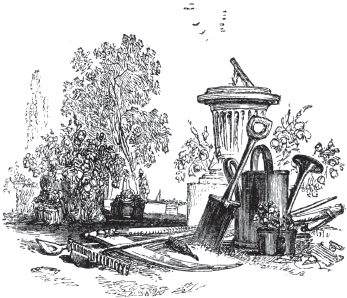

CHAPTER 1
A BRIEF HISTORY
OF HERB USE
T he history of herb use has its start in the constant pursuit of medical knowledge unique to the human race. When and how humans first realized that herbs could be both medicinal and edible remains unknown. Did they learn from the animals, watching what they ate when they were ill or hungry? Was it trial and error? Or did it come down to natural instinct?
While we may never know exactly how humans discovered the use of herbs, we do have a fairly detailed history of how they were used.
That said, the use of herbs goes back further than written history itself. Archaeological findings have shown evidence of their use back to the Paleolithic times, more than 60,000 years ago. Burial sites that have been uncovered show that these hunter/ gatherers may have had the knowledge to use herbs for medicinal purposes.
The Eber Papyrus, written by the ancient Egyptians around 1500 BCE, actually listed about 850 plants as medicine, many that we would recognize and still use today. It also shows the herbs and spices that were used at the time for culinary purposes, which are equally as familiar. Later, in the sixth century BCE, came the Sushruta Samhita, a writing that describes over 700 medicinal plants. In China, the Shennong Ben CaoJing listed over 360 plants and their medicinal uses.
Hippocrates, considered the father of modern medicine, was well known for using herbal remedies in his medical practice.

